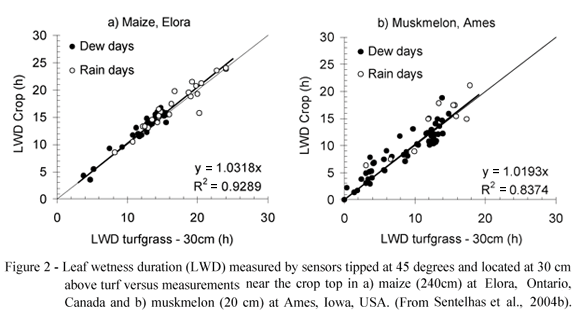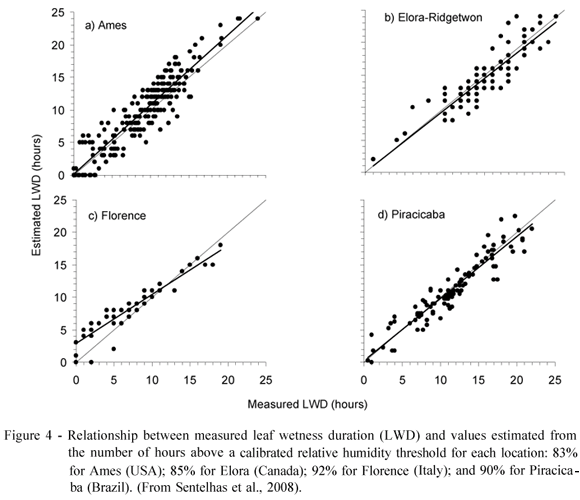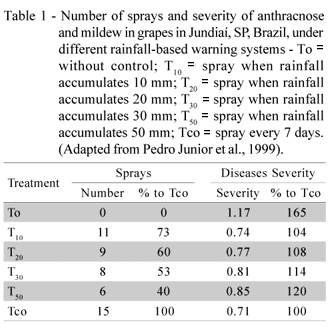Abstracts
Many plant disease outbreaks are triggered by suitably warm temperatures during periods of leaf wetness. Measurements or estimations of leaf wetness duration provided by Agrometeorologists have allowed Plant Pathologists to devise weather timed spray schemes which often reduce the number of sprays required to control plant diseases, thus lowering costs and benefitting the environment. In the near future, tools such as numerical weather models with small grid spacings, and improved weather radar, are expected to reduce the need for tight networks of surface observations. The weather models will also provide growers with forecast warnings of potential upcoming disease outbreaks, which will further enhance the contribution of agrometeorology to plant disease management.
leaf wetness duration; temperature; disease warning systems
A disseminação de muitas doenças de plantas é influenciada por condições favoráveis de temperatura durante o período de molhamento foliar. As medidas e estimativas da duração do período de molhamento foliar fornecidas pelos Agrometeorologistas têm permitido aos Fitopatologistas dar alertas sobre a necessidade de pulverizações com base nas condições meteorológicas, o que normalmente reduz o número de aplicações para o controle de doenças, resultando em menor custo de produção e menor contaminação do ambiente. Em um futuro próximo, ferramentas como os modelos numéricos de tempo, com alta resolução espacial, e os radares meteorológicos mais avançados, deverão reduzir a necessidade de redes de observação meteorológica de superfície mais densas. Os modelos meteorológicos também possibilitarão a previsão de disseminação potencial das doenças de plantas, o que irá aumentar ainda mais a contribuição da agrometeorologia para o controle fitossanitário mais racional.
duração do período de molhamento; temperatura; sistemas de alerta fitossanitário
POINT OF VIEW
Agrometeorology and plant disease management - a happy marriage
Agrometeorologia e manejo de doenças de plantas - um casamento feliz
Terry James GillespieI, * * Corresponding author < tgillesp@uoguelph.ca> ; Paulo Cesar SentelhasII
IUniversity of Guelph - Department of Land Resource Science - N1G 2W1 Guelph, ON - Canada
IIUSP/ESALQ - Depto. Ciências Exatas, C.P. 09 - 13418-900 - Piracicaba, SP - Brasil
ABSTRACT
Many plant disease outbreaks are triggered by suitably warm temperatures during periods of leaf wetness. Measurements or estimations of leaf wetness duration provided by Agrometeorologists have allowed Plant Pathologists to devise weather timed spray schemes which often reduce the number of sprays required to control plant diseases, thus lowering costs and benefitting the environment. In the near future, tools such as numerical weather models with small grid spacings, and improved weather radar, are expected to reduce the need for tight networks of surface observations. The weather models will also provide growers with forecast warnings of potential upcoming disease outbreaks, which will further enhance the contribution of agrometeorology to plant disease management.
Key words: leaf wetness duration, temperature, disease warning systems
RESUMO
A disseminação de muitas doenças de plantas é influenciada por condições favoráveis de temperatura durante o período de molhamento foliar. As medidas e estimativas da duração do período de molhamento foliar fornecidas pelos Agrometeorologistas têm permitido aos Fitopatologistas dar alertas sobre a necessidade de pulverizações com base nas condições meteorológicas, o que normalmente reduz o número de aplicações para o controle de doenças, resultando em menor custo de produção e menor contaminação do ambiente. Em um futuro próximo, ferramentas como os modelos numéricos de tempo, com alta resolução espacial, e os radares meteorológicos mais avançados, deverão reduzir a necessidade de redes de observação meteorológica de superfície mais densas. Os modelos meteorológicos também possibilitarão a previsão de disseminação potencial das doenças de plantas, o que irá aumentar ainda mais a contribuição da agrometeorologia para o controle fitossanitário mais racional.
Palavras-chave: duração do período de molhamento, temperatura, sistemas de alerta fitossanitário
The dependence of many plant disease outbreaks on weather conditions has been known to growers for a very long time. This dependence, and the emergence of Agrometeorology as a scientific discipline in the second half of the 20th century, has led to some excellent collaborative research between agrometeorologists and plant pathologists. This point of view highlights some of the successes and lessons learned in these collaborations, and looks into the future of Agrometeorology's role in plant disease management.
The key weather variables that trigger many plant disease outbreaks are temperature and moisture. Temperature affects all phases of plant disease whereas moisture is important for the infection process (germination and penetration) and release of spores. Very often, the moisture variables involved are relative humidity (RH), leaf wetness duration (LWD) or rainfall (R). When duration of high RH is the key moisture variable, as with some mildew diseases, the job of providing data is facilitated by routine measurements of RH and R at weather stations, and adequately accurate sensors are commercially available for field measurements. On the other hand, LWD is not routinely measured, and we have learned that special care is needed when constructing (suitable size and color) and deploying (tipped rather than horizontal) these sensors to ensure satisfactory measurements (Figure 1). For example, flat plate LWD sensors deployed horizontally stayed wet an average of 38 min and 56 min longer than plates tipped down 3045 degrees from horizontal in Elora, Canada (43º49' N, 80º35' W, 370 m), and Piracicaba, Brazil (22º42' W, 47º30 'W, 568 m), respectively; and plates tipped at 3045 degrees usually do a better job of matching the wetness on nearby crops (Figure 2, from Sentelhas et al., 2004b). Painting wetness sensors, to adjust their drying time to match crop leaves, strongly affects the sensors' performance (e.g. Gillespie & Kidd, 1978; Lau et al., 2000; Sentelhas et al., 2004a). Painting has been shown to reduce the coefficient of variation between sensors (Sentelhas et al., 2004a) from 67% (bare sensors) to 9% (painted sensors).
LWD can be estimated from meteorological measurements when deploying LWD sensors is not practical. The demands for input variables are high when the estimation scheme can be utilized directly in different geographic locations and crops - that is, when the scheme is very " portable" . In this case, required inputs are usually temperature, humidity, precipitation, wind and net radiation (e.g. Sentelhas et al., 2006). An approach that utilizes these variables and is based on the Penman-Monteith method of estimating evapotranspiration was shown to give good results in maize, grape, coffee, soybean and tomato crops in Brazil and Canada (Figure 3, Sentelhas et al., 2006). Obtaining good radiation data is often the biggest challenge since solar radiation observations are not nearly as common as temperature, humidity, precipitation and wind measurements; and longwave sky radiation is seldom measured so it must be estimated from cloud, humidity and temperature data. If we are willing to accept lower estimation accuracy in some cases, and use an LWD estimation scheme that may require local calibration before using it in different locations, then the input demands can be relaxed. For example, hours with RH above some threshold value may be a satisfactory estimator of LWD provided that appropriate thresholds are determined using local observations (Figure 4, Sentelhas et al., 2008).
The synergy between agrometeorology and plant pathology has yielded a number of schemes for more effective management of economically important plant diseases, and some of these schemes have also been used to evaluate the climatic risk for plant disease in studies about crop zoning. There are many crops where genetic resistance to disease is not sufficiently high, so chemical controls are necessary to preserve marketable yields. Suitable weather-based advice can allow optimal timing of these disease control measures. When spray applications timed by the calendar at regular fixed intervals are replaced by weather-timed applications, fewer sprays are usually needed and a " triple win" results. The grower wins twice by saving both money and time, and the environment wins because just the right number of sprays is applied. For example, in three years of using the TomCast scheme for timing fungicide sprays on tomatoes in Canada, 3055% fewer sprays were used when compared to a regular weekly application schedule (Gillespie et al., 1993). Another example was presented by Pedro Junior et al. (1999) for grapes in Jundiaí, SP, Brazil (23º06' S, 46º55' W, 720 m), where sprays against anthracnose and mildew were reduced by 40% with the use of a rainfall-based warning system (Table 1). Schemes are also being developed to use LWD data in the management of grape diseases (Figure 5).
For practical application, the most successful management schemes that have grown out of collaboration between agrometeorologists and plant pathologists are for situations where the plants can tolerate some moderate level of disease. In these cases, observations of temperature and moisture can be used to assign a disease severity value (DSV) rating to each day's weather, and these ratings can be accumulated to a threshold that triggers disease control action. An example is shown in Table 2 for the TomCast disease management scheme used in tomatoes (Gillespie et al., 1993). The first fungicide spray is applied after the DSV sum reaches 35, and additional sprays are applied each time 20 more DSV have accumulated. The key advantage here is that observed data can be used; no forecast is required. For situations where a single weather event can trigger economically significant disease damage (e.g. apple scab), then the more challenging task of giving advanced warning is often required for a grower to apply chemical coverage. It is still a difficult challenge for agrometeorologists to provide sufficiently accurate forecasts of disease-prone weather, especially when the source of moisture is scattered convective rain showers.
What future developments can be seen that will enhance the contributions of agrometeorology to plant disease management? At the present time, the delivery of weather-based disease management advice is confined to regions where a suitable set of weather stations can be deployed, and the data can be retrieved sufficiently quickly by phone or radio links. Such networks are not available in many locations where weather-based disease advice could be very useful. But high-resolution computer weather models are now providing all the hourly meteorological inputs required for the estimation of plant disease potential (temperature, humidity, precipitation, wind, and radiation) at grid spacing as small as 1 km. Their output within 12 hours of their initialization time is becoming accurate enough to compete with direct observations. Disease management schemes could therefore be run for areas not served by a ground-based network of measurements by utilizing this computer output twice daily.
The problem of correctly locating the occurrence of scattered convective rainfall, as mentioned above, would still exist. However, the use of weather radar could come to the rescue here.
A study utilizing weather radar in Canada showed that this technology was sufficiently good to provide the necessary information on rainfall durations to successfully run the TomCast disease management scheme for tomatoes. During the 2004 tomato-growing season at Elora in southern Ontario, Canada, there were 18 days when leaf wetness was caused by rainfall. Weather radar was used to determine the leaf wetness duration during these wet periods. The accumulated DSV total estimated from radar over these periods was only 2 DSV different from the value measured by leaf wetness sensors at the site. This is well below the error of 20 DSV required to initiate an unwanted spray (Rowlandson, 2006). We suggest that the time is ripe for in-depth evaluation of short term output from top quality computer weather models, combined with weather radar data, as potential tools to greatly enhance the spatial availability of weather-based disease management schemes.
Further in the future, as numerical weather models continue to improve, our ability to give forecasted warnings of impending disease-prone weather will be enhanced. This will be particularly helpful for those cases where growers must be prepared in advance to battle a single disease-favorable weather event, as discussed earlier. But it will also be helpful in currently operating schemes that allow disease to build to some threshold before control action is required. The ability to reliably forecast the arrival of a threshold a few days in advance would be a very useful tool for growers to use in their day-by-day decision making for upcoming farm tasks. Improvements like that in our ability to deliver appropriate weather-based indices will continue to enhance the contribution of agrometeorology to plant disease management.
Received November 01, 2007
Accepted February 27, 2008
- GILLESPIE, T.J.; KIDD, G.E. Sensing duration of leaf moisture retention using electrical impedance grids. Canadian Journal of Plant Science, v.58, p.179-187, 1978.
- GILLESPIE, T.J.; SRIVASTAVA, B.; PITBLADO, R.E. Using operational weather data to schedule fungicide sprays on tomatoes in southern Ontario, Canada. Journal of Applied Meteorology, v.32, p.567-573, 1993.
- LAU, Y.F.; GLEASON, M.L.; ZRIBA, N.; TAYLOR, S.E.; HINZ, P.N. Effects of coating, deployment angle, and compass orientation on performance of electronic wetness sensors during dew periods. Plant Disease, v.84, p.192-197, 2000.
- PEDRO JUNIOR., M.J.; PEZZOPANE, J.R.M.; MARTINS, F.P. Uso da precipitação pluvial para previsão de épocas de pulverização visando controle de doenças fúngicas na videira 'Niagara rosada'. Revista Brasileira de Agrometeorologia, v.7, p.107-111, 1999.
- ROWLANDSON, T.L. Use of precipitation duration data from weather radar in leaf wetness duration estimates for plant disease management. Guelph, 2006. 120p. Thesis (M.Sc.) - University of Guelph.
- SENTELHAS, P.C.; MONTEIRO, J.E.B.A; GILLESPIE, T.J. Electronic leaf wetness sensor: why it should be painted. International Journal of Biometeorology, v.48, p.201-205, 2004a.
- SENTELHAS, P.C.; GILLESPIE, T.J.; GLEASON, M.L.; MONTEIRO, J.E.B.A.; HELLAND, S.T. Operational exposure of leaf wetness sensors. Agricultural and Forest Meteorology, v.126, p.59-72, 2004b.
- SENTELHAS, P.C.; GILLESPIE, T.J.; GLEASON, M.L.; MONTIERO, J.E.B.A.; PEZZOPANE, J.R.M.; PEDRO JUNIOR., M.J. Evaluation of a Penman-Monteith approach to provide " reference" and crop canopy leaf wetness duration estimates. Agricultural and Forest Meteorology, v.141, p.105-117, 2006.
- SENTELHAS, P.C.; DALLA MARTA, A.; ORLANDINI, S.; SANTOS, E.A.; GILLESPIE, T.J.; GLEASON, M.L. Suitability of relative humidity as an estimator of leaf wetness duration. Agricultural and Forest Meteorology, v.148, p.392-400, 2008.
Publication Dates
-
Publication in this collection
22 Jan 2009 -
Date of issue
Dec 2008
History
-
Accepted
27 Feb 2008 -
Received
01 Nov 2007








